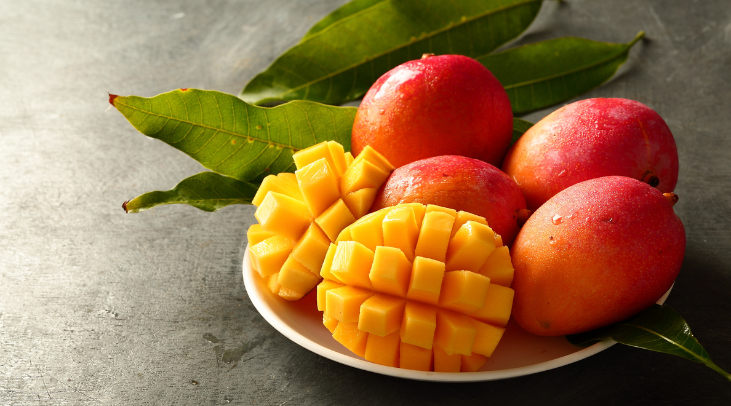India’s rich agricultural diversity has positioned it as a key player in the global export market. Each regional produce in the country boasts unique produce, cultivated through traditional methods that enhance its flavor, quality, and international appeal. This blog takes you on a journey through India’s regional specialties and their growing demand in export markets.
India’s rich agricultural diversity offers a vast array of regional produce that carries distinct flavors, textures, and cultural significance. Each region of India has its own signature fruits and spices, which present unique opportunities for export to global markets, allowing exporters to showcase the country’s agricultural heritage.From the fiery G4 Chilly of the Northeast to the sweet and tangy pomegranates of Maharashtra, Indian regional produce offers flavors that cater to a wide range of international tastes.
1. Alphonso Mangoes from Maharashtra

Known as the “King of Mangoes,” Alphonso mangoes are renowned for their sweetness, aroma, and smooth texture. Their export appeal lies in their exceptional quality and seasonal exclusivity.
Alphonso mangoes from Maharashtra are renowned worldwide for their exquisite flavor, smooth texture, and vibrant golden hue. Grown primarily in the Konkan region, these mangoes are often considered the “king of fruits” due to their unparalleled sweetness and richness.
The unique combination of the region’s tropical climate, fertile soil, and traditional farming methods contributes to the distinct taste that makes Alphonso mangoes highly sought after, especially in international markets like the UAE, the UK, and the United States.
Their juicy, fragrant pulp and minimal fiber make them ideal for both fresh consumption and in products like juices, jams, and ice creams. With their premium quality and seasonal appeal, Alphonso mangoes embody the essence of India’s agricultural excellence and continue to be a symbol of luxury and taste in global fruit markets.
2. Saffron from Kashmir

Kashmiri saffron, often called “red gold,” is prized for its rich color, flavor, and aroma. It’s a staple in luxury markets worldwide. Saffron from Kashmir is one of the most prized and sought-after spices in the world, known for its deep red threads, distinctive aroma, and rich flavor.
Cultivated in the high-altitude fields of Kashmir, this spice thrives in the region’s unique climate, where the cold nights and sunny days create the perfect conditions for its cultivation. Hand-harvested with meticulous care during the autumn season, Kashmiri saffron is known for its purity and potency, making it a symbol of luxury and refinement.
Its delicate floral notes and vibrant golden color enhance a wide variety of dishes, from traditional Indian sweets to international gourmet recipes. Beyond its culinary uses, Kashmiri saffron is also valued for its medicinal properties, often used in Ayurvedic practices for its antioxidant and anti-inflammatory benefits.
3. Darjeeling Tea from West Bengal

Dubbed the “Champagne of Teas,” Darjeeling tea is a globally recognized Geographical Indication (GI) product. Its unique flavor and aroma make it highly sought after by connoisseurs. Darjeeling tea’s global appeal is further enhanced by its authenticity and heritage. With the certification of the Darjeeling tea’s geographical indication (GI) tag, buyers are assured of its origin and quality.
Exporters of Darjeeling tea cater to a growing international market, where tea enthusiasts value its exceptional quality and the story behind every cup. Whether sipped in the tea rooms of London, the cafes of New York, or the homes of tea connoisseurs around the world, Darjeeling tea embodies the craftsmanship, tradition, and natural beauty of West Bengal, making it a prized export that captures the essence of India’s tea culture.
4. Pomegranates from Maharashtra

India is one of the largest exporters of pomegranates, particularly the Bhagwa variety, which is favored for its bright red arils and long shelf life. Maharashtra’s pomegranates are renowned for their exceptional quality, rich flavor, and numerous health benefits, making them a favorite in both domestic and international markets.
Grown predominantly in regions like Solapur and Baramati, the pomegranates from Maharashtra are known for their large size, deep ruby-red color, and juicy, sweet-tart arils. The state’s favorable climate and fertile soil contribute to the superior taste and texture of these fruits, which are harvested during the peak season from October to February.
5. Spices from Kerala

Kerala’s spices, such as black pepper, cardamom, and cinnamon, are known for their superior quality and are in high demand across global markets. Spices from Kerala are globally revered for their exceptional quality, rich aroma, and distinctive flavor profiles, making the region a hub for spice production. Known as the “Spice Garden of India,” Kerala’s fertile soil and tropical climate create the perfect conditions for cultivating a wide variety of spices, including cardamom, black pepper, cinnamon, cloves, and turmeric.
Why Regional Produce Thrives in Export Markets
- Unique flavors and qualities that cater to niche markets.
- High nutritional value, aligning with global health trends.
- Strong cultural associations, enhancing their appeal.
Conclusion
India’s regional produce is a testament to its agricultural diversity and heritage. By leveraging the unique qualities of these products, we not only preserve traditions but also open new doors to international markets with freshhly picked.
The temperate regions of Himachal Pradesh and Jammu & Kashmir are known for their crisp apples and stone fruits, which have found a strong market in Europe and the Middle East. Meanwhile, the fertile plains of Assam and West Bengal yield premium-quality rice and ginger, prized for their authenticity and robust taste. Down south, Kerala and Tamil Nadu are known for their cardamom, pepper, and coconut, ingredients that are integral to global cuisines.
Understanding the unique appeal of these regional products, coupled with their cultural significance, allows exporters to position them effectively in international markets. Whether it’s highlighting the health benefits of turmeric from Karnataka or the rich flavor of Basmati rice from Punjab, the key lies in embracing the uniqueness of each region and tailoring marketing strategies to align with global consumer preferences.
By exporting these regional treasures, Indian exporters not only bring the world closer to India’s rich agricultural heritage but also foster a deeper appreciation for the diverse and flavorful produce that defines the country’s culinary landscape.
Explore the taste of India through its regional gems!

